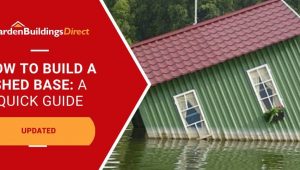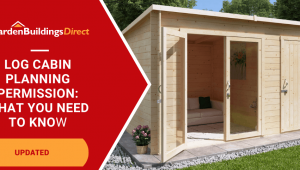Jump to:
Moisture can cause rot; pests may infest the wood, and wear and tear compromise its stability. These issues are common in wooden garden sheds, especially if maintenance is neglected. Take note of the routine tips below to keep your storage building in good shape.
1. Check the condition of your shed

Giving the building a close look-over from all angles is a good way to identify any present concerns around the building. Pay attention to the surfaces and see if you can spot any rotting parts and loose joints. Look for any signs of wear and tear and visible cracks.
Pay close attention to the roof for any gaps starting to form that could let rain water through, particularly on sheds with tiled roofs. Go up on a ladder if necessary to ensure you are getting a close enough look.
Don’t forget to check the foundation; you’ll want to make sure it’s stable and still level. Moisture often causes rotting wood, while loose joints result from ageing. An uneven foundation can cause the shed to shift and become unstable over time. Addressing these concerns before beginning maintenance is important. Failure to do so could only worsen the situation.
2. Repair or replace damaged wood parts

Look for signs of decay, such as soft or spongy wood, cracks or splits, and holes or tunnels. If any of these indicators are present, take action as soon as possible to prevent further damage.
For minor damage like small cracks or splits, use a wood filler to help restore the wood. But for more significant issues such as rot or decay, you may need to replace the concerned boards. Consider treating both the new and repaired wood with preservatives for further protection.
What causes these? Moisture promotes mould growth within the wood fibres, leading to damage. Similarly, pests such as wood-boring beetles tunnel through the wood, weakening its structure.
3. Reinforce additional support
Extra support can strengthen the shed and prevent it from shifting or settling over time. Installing braces, which are diagonal pieces of wood, can uphold the walls and roof. Alternatively, pair joints with metal plates to prevent the wood from splitting.
You might want to consider this if you notice signs of structural weakness, such as slight sagging in the roof or walls. Adding braces or metal plates can provide the extra stability needed.
Note: Always adhere to safety protocols when handling power tools and heavy materials. Consult a professional if you’re unsure how to do it yourself.
4. Ask for professional help

There are times when it’s wise to entrust the job to professionals, especially if the damage is extensive. A fitting example is when the base and foundation have significantly weakened. You begin to notice large cracks in the concrete base, and sections of the foundation are sinking. Even worse, the wooden garden shed itself begins to tilt or lean to one side.
These situations require specialised knowledge, equipment, and skills. Experts can assess the extent of the damage and determine the best way to stabilise the base. If you’re facing challenges beyond your expertise, don’t hesitate to seek help from the pros.
5. Improve airflow with windows and vents
Proper ventilation is crucial to prevent moisture buildup. If this issue is overlooked, it can lead to wood rot and damage. Placing windows and vents is an effective way to promote air circulation within the shed. Not only does this help maintain optimal humidity levels, but it also brings in more natural light, keeping the interior airy and fresh.
Tip: Concerned about unwanted pests invading your shed? Add insect curtains or screens to your windows and vents to keep them at bay.
6. Reapply paint and finish

A fresh coat of paint can do wonders for the appearance and longevity of your garden shed. Choose high-quality exterior wooden garden shed paint that can withstand the elements.
Before painting, sand and prime the wood to create a smooth and even surface. Select a colour that complements your garden’s aesthetic. Don’t forget to apply a sealant or clear shed protection to protect the wood from UV rays and moisture.
Round-up
Investing time in maintaining your wooden garden shed is worthwhile. By following these tips, you can fortify it against the elements and ensure its longevity. Don’t wait until it’s too late — start making these improvements ASAP and enjoy the benefits for years to come!
Next on your reading list for more tips: How to Insulate a Shed
If you have any further questions, please don’t hesitate to contact us at 01909 768840.





